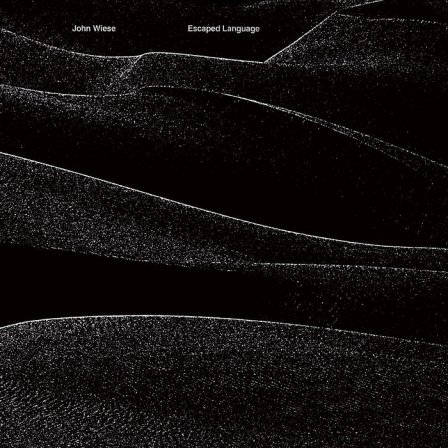Escaped Language is John Wiese’s latest record. It’s his 2nd solo full-length for Gilgongo and 422nd release overall. Caveats:
- This number includes collaborations, compilation tracks, singles, 10-inches, 7-inches, and work with his other projects, including Sissy Spacek and Bastard Noise.
- This number is the result of my own calculations. If you want to double-check, please do.
- This number is not particularly impressive in the rarefied world of noise music. Merzbow, for example, has Wiese handily beat.
The last point here is worth pondering. Aside from the auditory pleasure to be found in sheer abrasive sound, there is a curatorial pleasure in traversing the branching nodes of noise music’s network. Creating a taxonomy of the relationships between noise artists and their side projects, collaborators, and labels is a never-ending pursuit that gratifies the basest urges of the most devout completist. Wiese is familiar with this compulsion for comprehensiveness. In 2011, he displayed his first 100 7-inch singles in an L.A. gallery. He was contacted by fans who were able to collect up to 96 of these. I’m sure he received this news with a mix of humility and schadenfreude: better to keep the search alive.
The decentralized, collaborative nature of this ultra-prolific mode of production is both aesthetic and political. This is purposeful noise in the system of noise music, designed to resist the corporate structure surrounding the traditional album format and its attendant news cycle. But this poses a problem for musicians and reviewers alike: how to give each release its due consideration? Inevitably, the album format wins out. In Wiese’s case, his most traditional albums — Soft Punk (2007), Circle Snare (2009), Seven of Wands (2011), and Deviate From Balance (2015) — have garnered the majority of critical attention.
Escaped Language rests on the border between a single and a traditional live album (which are always considered “minor” pieces in an artist’s oeuvre anyway). It is a one-sided LP consisting of a single 19-minute track, recorded at Wiese’s show at 2016’s Ina/GRM Présences Électronique Festival in Paris. Ultimately, it may take a minor position in Wiese’s discography, but it nonetheless serves as a useful document of his approach to live performance. Wiese visualizes each live show as a step along a route from A to Z. He might consciously make each show as different from the last as possible or attempt to recreate the same show each time, learning and adapting from the changes that inevitably occur. Sometimes he records a show and mines it for samples in the next, creating a sort of sonic palimpsest of his tour to that point. Documents of this process are rare; those that exist were originally released on 7-inch, cassette, or CD. That Wiese includes Escaped Language among his readily available “traditional” albums speaks to a sense of its importance as representative of his live praxis.
And it’s true: many of the elements of the sonic world Wiese has carefully built for years are here. The piece begins with a short ambient introduction before combining a series of disparate organic sounds, juxtaposing metallic percussive patterns with ominous moans and shuffles that evoke a trip through a desolate sci-fi backwater. Wiese often has more in common with field recordists like Jason Lescalleet than with his noisier collaborators in Wolf Eyes and Prurient, and it is this aspect of his work that is emphasized. He creates a moody, complex sonic environment and sustains it; the sounds are enough to unsettle, but not to startle. Wiese credits his careful manipulation of dynamic range to his background in typography and graphic design, and it’s easy to imagine the relative aural positions of these sounds being described in visual terms. Escaped Language is not a grand statement on the scale of Circle Snare or Deviate From Balance, but perhaps it deserves attention on exactly this score. Characteristic but not canonical, it documents the practice of a careful craftsman at work.
More about: John Wiese




